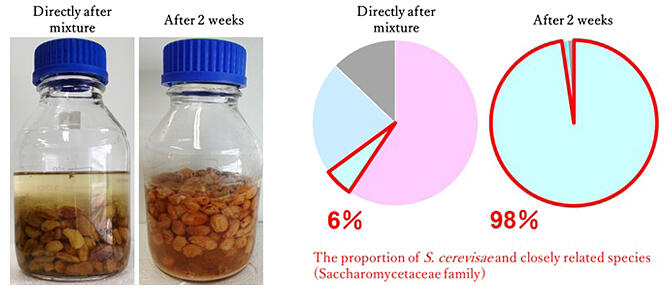Wine is believed to have existed as early as the Neolithic period. However, many mysteries remain regarding how humans developed the ability to make wine. The prevailing theory was that wine yeast, capable of alcoholic fermentation, was present on the skins of grapes, the raw material from which wine is made. The wine yeast would mix with the grape juice during pressing and spontaneously initiate alcoholic fermentation. However, a recent detailed analysis indicated that unbroken grape skins cannot be fermented into alcohol and have only a low level of resident microorganisms.
Associate Professor Daisuke Watanabe of the Nara Institute of Science and Technology and Professor Wataru Hashimoto of the Graduate School of Agriculture at Kyoto University have succeeded in reproducing the process of wine yeast adaptation to grape skins in the laboratory, and had their results published in Scientific Reports.

Provided by Kyoto University
Baker's yeast is a microorganism called Saccharomyces cerevisiae, the same yeast used to produce wine. It causes bread dough to rise by producing carbon dioxide gas via alcoholic fermentation. In the days before baker's yeast was readily available, it was obtained by adding water to dried raisins and keeping it warm for several days. This was then used as a baking ingredient.
Raisin yeast was prepared from commercially obtained raisins. Using metagenomic analysis, a high-throughput genetic analysis that allows identification of the spectrum of organisms present in a sample, they showed that 98 % of the community of microorganisms or microflora present on the raisins comprised S. cerevisiae and other yeasts with a strong ability to produce alcohol by the process of fermentation in 2 weeks. Based on this, the hypothesis that wine yeast grows on grape skins during the transformation from grapes, where wine yeast is virtually absent, to raisins was investigated in an experiment.
Grape berries were dried in a sterile oven in the laboratory to produce raisins, and the microflora present in the fleshy part (pericarp) of the raisins was studied by metagenomic analysis. They observed that S. cerevisiae and related yeast species did not grow during raisin production in the laboratory. However, they did grow when small amounts were artificially attached to grape skins beforehand. Wine yeasts from the surrounding environment, insects, birds, and other animals, attach themselves to the grape skins, triggering the formation of raisins that contain wine yeasts.
This raises the question of why it is so difficult for wine yeasts to reside on grape skins.
In the study, the fungus Aureobasidium pullulans, one of the typical microorganisms on the grape skin, was isolated from domestic grapes and compared to S. cerevisiae, to which many wine yeasts belong. The grape berry is surrounded by a rigid cell wall structure, of which the outermost layer is a complex lipid layer called the cuticular layer. S. cerevisiae cannot act on the cell wall or cuticular layer. However, A. pullulans releases enzymes that can degrade the cell wall and cuticular layer.
Although S. cerevisiae cannot utilize the products produced by digestion of the cell walls and cuticular layers as a nutrient source, A. pullulans can utilize several of these plant surface-derived components, such as cellobiose, galacturonic acid, and ω-hydroxypalmitic acid, as a single carbon source for its growth. In particular, microorganisms capable of utilizing ω-hydroxypalmitic acid, the digestion product of the cuticular layer, have been observed in grape skins for the first time.
This experimental evidence explains why wine yeast is not readily present on grape skins: it cannot break down the cell wall and cuticular layer to produce energy for its use. In addition, tests were conducted under conditions that mimicked the spontaneous fermentation process involved in wine production.
First, they added glucose, which can be easily fermented into alcohol, to a basic growth medium and measured the rate of carbon dioxide production. They showed that S. cerevisiae easily caused fermentation, whereas A. pullulans barely resulted in fermentation. When the two microorganisms were grown together as a mixed culture, the rate of carbon dioxide production, indicating the rate of fermentation, was comparable to that of S. cerevisiae alone.
Second, when intact fresh grape berries were added to the basic growth medium, S. cerevisiae showed a delay in starting alcoholic fermentation compared to when glucose was added to the basic growth medium. A. pullulans exhibited little fermentation ability. However, when grown with S. cerevisiae produced carbon dioxide at a higher rate than did S. cerevisiae alone.
These results suggest that the cell wall and cuticular layer of the plant surface act as barriers, preventing S. cerevisiae from accessing sugars inside grapes for alcohol fermentation. However, A. pullulans degrades and consumes the cell wall and cuticular layer, which may contribute to alcohol fermentation by giving S. cerevisiae access to the sugars in the flesh of the grapes. This study revealed that wine yeast needs to be adapted to grape skins through raisining.
The importance of analyzing the three-way interaction between the fermenting material (grapes), the fermenting microorganism (wine yeast), and the other resident microorganisms originally present in the fermenting material was demonstrated.
Hashimoto said, "There are various popular theories about the origin of fermentation and vinification that are difficult to prove. This research has addressed the birth of wine through experimental methods. Our research represents a journey in the footsteps of mankind's discovery regarding the power of microorganisms to transform raw materials into fermented foods, and it is significant in the rediscovery of knowledge that can be applied to modern fermentation technology."
Watanabe commented, "Yeast, which carries out alcoholic fermentation, is a familiar microorganism to humans. However, their life cycle remains unclear. This study has clarified that wine yeast does not live on grapes; however, it has created a new mystery as to the location of its original home. We will continue to try to discover this."
This article has been translated by JST with permission from The Science News Ltd. (https://sci-news.co.jp/). Unauthorized reproduction of the article and photographs is prohibited.




